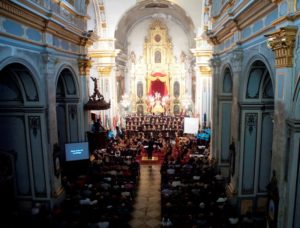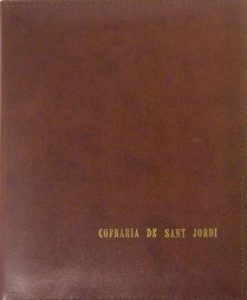"They announce the visits of the main men of the town. I'm going to hang the curtains. After and before my trip to Nucía, I need to kill flies and spiders, commissioned by the whole family. I am a Saint George in pajamas ".
This beautiful and carefree paragraph corresponds to our great Alicante novelist Gabriel Miró, unjustly forgotten because it represents the maximum
figure, together with Azorín, of the Alicante narrative in Spanish, using a rich and varied language revitalizing lexicon. The quote comes in the letter 635 of his “Epistolary”, directed at 7 June 1926 to his friend Heliodoro Carpenter from Polop, where the family spent summers to take care of the battered health of his wife and forget the administrative work in Madrid, that never freed him from his financial straits.
—–
Since the taking of Granada by the Catholic Monarchs, a process of conversion of the Mudejars begins (later Moorish), that would last until his expulsion from Spain in the year 1609, proselytizing that would experience numerous episodes of fanaticism and carnage, until boarding on this date, towards African lands, close up of 300.000 Valencian Spanish, made stateless. The long and unsuccessful attempt at conversion, would affect society in such a way that, both the authorities and the people, they considered the Moors as an embedded problem, celebrating, especially since his expulsion in 1609, the triumph over them, with festive representations in which the Christians defeated the Moors. On the other hand, the danger of the incursions of Moorish pirates on the Spanish coasts was always present, and very especially in the Valencian ones, along with the Ottoman threat, always latent.
The first time the town intervened in a mock combat with a wooden castle was at the festivities held in Toledo, the 6 May 1533, on the occasion of the landing of Carlos I in Barcelona, where the carpentry and masonry guilds, grouped into two sides, one of Moors and one of Christians, they face in close fight. It is in this sixteenth century when the combats of "Moors and Christians" are frequent..
In 1560 and in the long journey of the nuptial procession on the occasion of the marriage of Felipe II with his third wife Isabel de Valois, during your stay in Toledo, various parties and entertainments are held, not missing a bullfight and a spear tournament, with the final auction: 3.000 Veterans of the Spanish Tercios and a Moorish cavalry engage in simulated combat (Bennassar, 2006,
18).
The ancient comedies of Moors and Christians, that were in fashion from the end of the 16th century to the first third of the 18th century, in which the fight of Good against Evil was represented, incarnated in the Angel and the Devil, they evolve towards the later ones with the anger towards the Moors and the fight against the Turks. To the first corresponds, among other, the representation of "Moros y Cristianos" of Zújar (Córdoba).
In Aínsa (Huesca), festivals are held annually to commemorate the victory against the Moors in a battle that took place in their surroundings, in the year 724. In the morning, at the ringing of the bells, in a kind of procession, the Moors parade along the wall and the Christians go down the Calle Mayor to the square. There is a skirmish, with undecided winner and, in the end the Moors run until an era, producing another skirmish, and "upon reaching the square a campaign mass is celebrated, which is also mocked by the Moors at a distance of about two hundred meters". A shepherd recites a romance and at his signal, a Moor shoots his arquebus as the beginning of the general arquebusiería, Losing the Christians their flag. Later, the Moors flock to the plaza losing the battle and simulating the Christians to cut off the head of the Moorish chief. The show ends with the "dance of the Moorish". (Sender, III, 90).
The expulsion of the Moors decreed, part of these revolt against the order, among them the inhabitants of the Laguar Valley, to which he submits after bloody skirmishes and mass killings in his final stronghold of Petracos. To celebrate the victory, Patriarch Ribera organized a procession from the Cathedral to the Corpus Christi College, repeating every year the 21 of November, surrender date (Muñoz, 2010, 148).
In the Laguar Valley campaign, the Effective Militia participates in the assault on Pop's castle, between 22 Y 29 November 1609. The first company to present itself was that of Biar, under the command of Jaime Almunia. Six companies showed up from Alicante, together with those of Villajoyosa, Jijona, Cocentaina, you, there, Castalla, Bocairent and others, quartered between Tàrbena and Castell de Castells. All these companies, encompassed in what was called "the third of the Mountains", located near the castle, they were ordered to wait for the advance of the bulk of the army, the famous thirds, to cut the retreat of the rebels, mission that they successfully fulfilled, not without dedicating himself to looting when finding a large quantity of supplies and clothes, with what they did great business. After the surrender and massacre of Moors, the Effective Militia is dismissed after satisfying the corresponding salaries.
Bocairent's company was made up of 564 soldiers with 3 captains and 387 arcabuces. In the same several residents of Banyeres were integrated, since this was still annexed to the first as "carrer de Banyeres", being undoubted that this experience would reinforce the riots and representations of struggles between Christians and Moors in our city and the rest of the province of Alicante (Lomas, 2009, 164-211).
Is present, throughout the seventeenth century, fear of Ottoman danger. In 1687, on the occasion of the marriage of Pedro II and Sofia de Neoburgo, in lisbon, a spectacle represented the storming of a fortress defended by the Ottomans, with great pyrotechnic display, replacing two crescents by two crosses (Vincent, 2006, 87). The fear of the Turks was stoked by the authorities with the continuous accusation of relations between the Moors and the Ottomans, in fear of an invasion of these by the coasts, as the seizure and sacking of Citadel in
1558.
It is in the eighteenth century when the "Moors and Christians" festivities, as we know them today, reach maturity. The oldest date is from the year 1715, in Alicante, where a Moorish landing is simulated, declaiming an embassy to the Christians who defend the castle, located in the Plaza Mayor, who refuse to surrender and the Moors take the fortress by storm. In the afternoon it is the Moors who lose the castle, behind the embassy. From this date on, the model became popular in several cities., both Valencian and foreign, especially on the occasions of royal visits or proclamations. (Muñoz, 1972, 18).
The dances or dances of Moors and Christians stage the fight between the Cross and the Media Luna. Its origin is in the Moorish dances that were fashionable in the European courts for more than two centuries, later replaced by gypsy and flamenco dances. Three types of dance are distinguished: individual, of couples and of "group, whose dancers, provided with clubs or weapons, they mimicked fighting a fight ". (Amades, 1966, 11).
The Moors were not impassive before the Christian representations. The festivals that the Moors enjoyed, as well as the comedies with a classic or pastoral theme that they represented in their towns, they were rejoicing at the Christian defeats inflicted by the Turks. (Bernabé, 2009, 61).
Through centuries and ancestral commemorations in scattered places, we have all the elements that make up the Festival of Moors and Christians: castle or wooden fortress in Toledo, Lisbon and Alicante; arquebusier in Aínsa and Toledo; campaign mass in Aínsa; beheading of the Moor (later, that of Muhammad in some places) in Aínsa, dances or dances in Aínsa and Amades, and embassies in Alicante and Aínsa.
BIBLIOGRAPHY
Amades, Joan: The dances of Moors and Christians. Alfonso the Magnanimous Institution. Valencia, 1966.
Bennassar, Bartolomé: The Spain of! Golden age. RBA Collectibles, S.A. Barcelona, 2006.
Bernabé Pons, Luis R: Moors. Conflict, expulsion and diaspora. Waterfall. Madrid, 2009.
Lomas Cortés, Manuel. The port of Denla and the Moorish exile (1609-1610). University of Valencia, 2009.
I look, Gabrel: Epistolario. Alicante Institute of Culture Juan Gil-Albert. Alicante, 2009.
Munoz Lorente, Gerardo: The expulsion of the Moors in the province of Alicante. Editorial Club Universitario. Saint vincent, 2010.
Muñoz Renedo, Carmen: The representation of “Moors and Christians”of Zújar. Madrid, 1972.
Sender, Ramón J.: Chronicle of dawn. Editorial Alliance. Madrid, 1971,3 vols.
V / inrpnt RprnarH- Fl rín mnr’Krn I Ink / prdtat rlp / ^ lpnr¡3 9006











